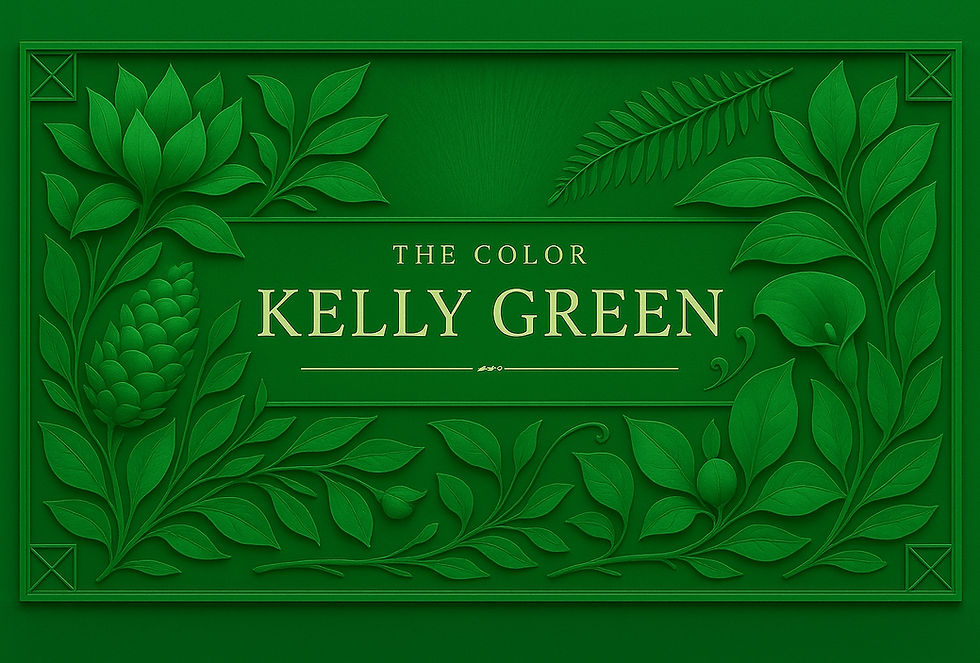Olive Green: Everything to Know About the Color Olive Green
- The Finest Writer

- May 4
- 4 min read

Welcome to our earthly guide on the grounded and timeless color olive green. This article will explore its meaning, symbolism, history, and versatile uses in art, design, fashion, and culture.
Olive green is a muted, natural shade of green with strong ties to nature, resilience, and balance. Its warm, subdued tone makes it a staple in military uniforms, fashion, and home decor, evoking feelings of stability and connection to the earth.
Whether you're considering olive green for your next design project or fashion choice, or simply curious about its deeper meanings, this article provides everything you need to know about the color.
What Color is Olive Green?

Olive green is a dark, yellowish-green color that takes its name from the hue of unripe olives. It combines the calming qualities of green with the warmth of yellow and brown undertones, resulting in a muted, earthy tone.
Olive green carries a sense of grounding and practicality. It is often associated with the natural world, military attire, and rustic aesthetics.
How to Make Olive Green?

Olive green is created by blending green with yellow and a touch of red or black to mute the brightness and create its characteristic earthy tone.
Olive Green RGB Values
Red: 128
Green: 128
Blue: 0
Olive Green HEX Color Code
The HEX code for olive green is #808000.
Olive Green CMYK Code
Cyan: 0%
Magenta: 0%
Yellow: 100%
Black: 50%
Paint Mixing to Create Olive Green
To create olive green with paint, start with a base of green and add yellow to warm it. Gradually muted or blackened to mute the tone and achieve the desired earthy feel. Adjust the balance of yellow, green, and darkening colors to fine-tune the shade.
Light and Perception of Olive Green
Olive green’s appearance can shift depending on lighting and surrounding colors. Under warm lighting, its yellow undertones become more pronounced, while cooler lighting may bring out the green elements more strongly.
What Colors Match Olive Green?

Olive green pairs well with various colors, offering earthy and sophisticated palettes. Here are some standout combinations:
Green and Beige: This natural pairing feels warm and organic, perfect for rustic or minimalist aesthetics.
Olive Green and Navy Blue: Navy adds depth and refinement to olive green’s earthy tone, creating a balanced and classic combination.
Olive Green and White: White lightens olive green, adding freshness and contrast while maintaining a clean, grounded feel.
Olive Green and Orange: This warm, complementary pairing feels rich and inviting, evoking autumnal or vintage styles.
Olive Green and Blush Pink: Soft pink contrasts with olive green’s earthy tone, creating a contemporary palette.
Olive Green and Charcoal Gray: ChgreChgreen's deepens green’s grounding quality, creating a sleek and sophisticated look.
What is Olive Green's Complementary Color?

On the traditional color wheel, olive green’s complementary color is purplish blue or violet. These fabulous shades contrast beautifully with olive green’s warmth, offering balance and visual interest.
What Colors are Similar to Olive Green?

Olive green shares characteristics with several other muted, earthy tones. Here are some related colors:
Army Green: A slightly darker, more uniform version of olive green, often used in military clothing.
Moss Green: Darker and richer, moss green carries more green with less yellow influence.
Sage Green: Lighter and softer than olive green, sage green has more gray tones.
Khaki: More beige and brown than olive green but shares its earthy warmth.
Avocado Green: A brighter, yellow-toned green often associated with retro design.
What Does Olive Green Symbolize?

Olive green carries rich symbolism across various cultures and contexts. Here are some of its most common associations:
Peace and Harmony: Derived from the olive branch, a symbol of peace, olive green represents reconciliation.
Silence and Strength. Olive green is a staple in military uniforms, symbolizing endurance, strength, and practicality.
Nature and Grounding: Olive green’s earthy tone connects it to the natural world, evoking feelings of stability, renewal, and environmental awareness.
Sophistication and Maturity: Its muted tone adds a sense of refinement and maturity, making it popular in fashion and design.
Earthiness and Warmth: Olive green is associated with rustic environments and natural beauty, offering warmth without brightness.
The History of Olive Green

Olive green has been significant in history, especially in military and cultural contexts. Here are some highlights:
Ancient Civilizations: The olive tree, from which the color draws its name, was central to many ancient cultures in the Mediterranean. Olive green represented peace, abundance, and connection to the land.
Military Use: Olive green became widely adopted for military uniforms in the early 20th century, especially during World War I and World War II. Its muted tone provided camouflage in various environments, while also symbolizing resilience and solidarity.
Fashion and Design: In the mid-20th century, olive green expanded into civilian fashion and interior design, associated with outdoor gear, workwear, and earthy aesthetics.
Modern Use: Today, olive green remains popular in fashion, home decor, and environmental branding. It represents eco-consciousness, strength, and timeless style, balancing rustic charm with modern minimalism.
Olive green is more than just an earthy shade. It is a symbol of resilience, balance, and connection to nature. Whether used in fashion, design, or creative projects, olive green brings warmth, grounding, and understated sophistication.




